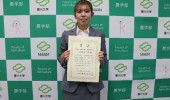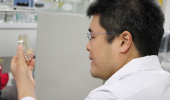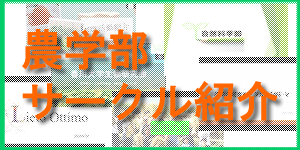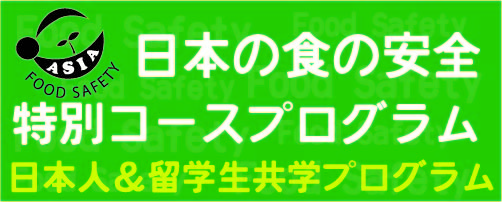領域名 環境生態機能学
教員指名 山田佳裕
研究分野 水環境科学

研究キーワード:物質循環, 生態系, 水循環, 水利用, 生物生産

最近の研究課題
1. 水資源に乏しい流域の水利用と水環境との関係に関する研究
地球温暖化による降水の偏在化は、日本を含むアジア・オセアニアを中心に進むことが予想されており、すでに現実のものになっている。将来には、降水量が減少する多くの地域で、食糧生産や生活基盤の維持のためにより効率的な水利用が求められ、適正な水利用のありかたを理解し、持続的に水や生物資源を利用するための研究が必要になる。本研究では、水資源の乏しい瀬戸内地域の主要流域を対象に、流域レベルの水・物質循環を解析し、陸域の水利用によって引き起こされる河川〜海域の水質汚濁・生態系改変のメカニズムを明らかにする。そして、得られた結果をもとに、自然の物質循環・生態系に負荷の少ない持続的な生物生産のための水利用システムを提示することを目指している。
2. 陸域の水・物質循環と沿岸海域の食物連鎖の相互関係に関する研究
陸水域における有機物汚濁は沿岸海域へ供給される物質の組成を大きく変える。相対的に、海域の一次生産に必要な栄養塩が少なくなり、外来性有機物の淡水性藻類が多くなる。この変化は沿岸海域の生物生産と食物連鎖に撹乱をもたらす。本研究では河川、干潟、沿岸海域における淡水性藻類の動態(捕食・分解・流出)を定量的に解析し、瀬戸内海の食物連鎖における淡水性藻類の寄与を定量的に明らかにすることで、健全な陸-海域の生物生産のあり方を提言する。
3. 水環境アセスメント手法の研究 ー水・物質環境マップの作成ー
グローバルな環境変動に各地域が対応するには、地域社会の環境に応じた取り組みを促すための研究が必要であり、国際的地球環境研究でも重視されている。従来、水循環研究は水温や水位などの物理的手法が用いられてきたが、現在では各種の安定同位体や主要・微量元素を用いた様々な物質トレーサー技術が提案されている。物質をトレーサーとして用いることで、水循環と物質動態のプロセスを同時に、高精度で追跡できるようになる。本研究の特色は、簡易測定から高度分析までの各種技術をトレーサビリティー手法として統合し、地域の水環境保全にむけたモニタリング手法として実践することにある。

代表的な研究業績
Yamada, Y., Fukuda, T., Omori, K., Nakano T.: Origin of particulate organic matter in river with remarkable water pollution in Shikoku Island, Japan, Limnology16, 127-137, 2015.
Fukuda, T., Nozaki, K., Yamada, Y.: Contribution of Phytoplankton to River Organic Pollution in the Basin with Scarce Water Resource: Ecology and Civil Engineering 17, 89-99, 2015.
Wada, E., Ishii, R., Aita, N. M., Ogawa, O. N., Kohzu, A., Hyodo, F., Yamada, Y.,: Possible ideas on carbon and nitrogen trophic fractionation of food chains: a new aspect of food-chain stable isotope analysis in Lake Biwa, Lake Baikal, and the Mongolian grasslands: Ecological Reaserch, 28, 1173-181 (2013)
Yamada, Y., Mito, Y, and Nakashima S.: Organic pollution in dammed river water in a low-precipitation region of Japan, Limnology 11, 267-272 (2011)
山田佳裕, 三戸勇吾, 堤裕昭: 降水量の少ない地域における水質汚濁の著しい河川から沿岸海域への有機物の供給, 沿岸海洋研究 49,79-89 (2011) 平成23年度日本海洋学会沿岸海洋研究会 速水論文賞
山田佳裕: ダム湖における水質形成の特徴と安定同位体比を用いた富栄養化の解析:ダムと環境の科学Ⅱ 大森浩二・一柳英隆編著, 京都大学出版会, 199-226(2011)
Area of Specialization: Environmental & Ecological Sciences
Study field: Water Environmental Science
Name: YAMADA, Yoshihiro

Key ward:water resources, material circulation, ecosystem, stable isotope

Recent Research
1. Study on the relationship between water use and environment in a basin with poor water resources.
The uneven distribution of precipitation caused by global warming is expected to intensify, mainly in Asia and Oceania, including Japan In areas of reduced precipitation, more efficient water use will be required for food production. Therefore, it is necessary to have an understanding of the proper use of water, and to study ways of sustainable utilization of water, and biological resources. In this study,we analyzed water and material circulation at the basin scale for the watershed of the Seto Inland Sea Region, which has poor water resources. We elucidated the mechanism of water pollution ecological alteration from river to marine areas caused by water use in terrestrial areas. Based on the results obtained, we aimed to present a water use system for sustainable biological production,which imposes a smaller burden on natural substance circulation and ecosystem.
2. Study of interrelationship between water circulation in the basin and the food chain in coastal waters.
Organic pollution in the basin significantly changes the composition of substances transported by the river to the coastal areas. There is a relative decrease in the nutrients necessary for primary production in the sea, and a relative increase in the organic matter in the form of freshwater algae. This change disturbs the biological production and food chain in the coastal waters. In this study, we quantitatively analyzed the dynamics ( predation, decomposition, and outflow) of freshwater algae in rivers, tidal flats, and coastal waters. Further, we quantitatively clarify the contribution of freshwater algae in the food chain in the Seto Inland Sea. Thereafter, we proposed a mechanism to balance biological production between land and ocean areas.
3. Development of Assessment method of Water Environment – Water /Substance Environment Map.
Conventionally physical parameters, such as water temperature and water level have been used in water circulation research. Recently, however, tracer technologies using various stable isotopes and major/trace elements have been proposed. Using these substances as tracers enables the effective tracing of water circulation processes and substance dynamics. The feature of this research is that it integrates various traceability methods and practices to monitor basin water conservation.

Publications
Yamada, Y., Fukuda, T., Omori, K., Nakano T.: Origin of particulate organic matter in river with remarkable water pollution in Shikoku Island, Japan, Limnology 16, 127 137, 2015.
Fukuda, T., Nozaki, K., Yamada, Y.: Contribution of Phytoplankton to River Organic Pollution in the Basin with Scarce Water Resource: Ecology and Civil Engineering 17, 89 99, 2015.
Yamada, Y., Mito, Y, and Nakashima S.: Organic pollution in dammed river water in a low precipitation region of Japan, Limnology 11, 267 272 (2011
このページの管理者:管理者















